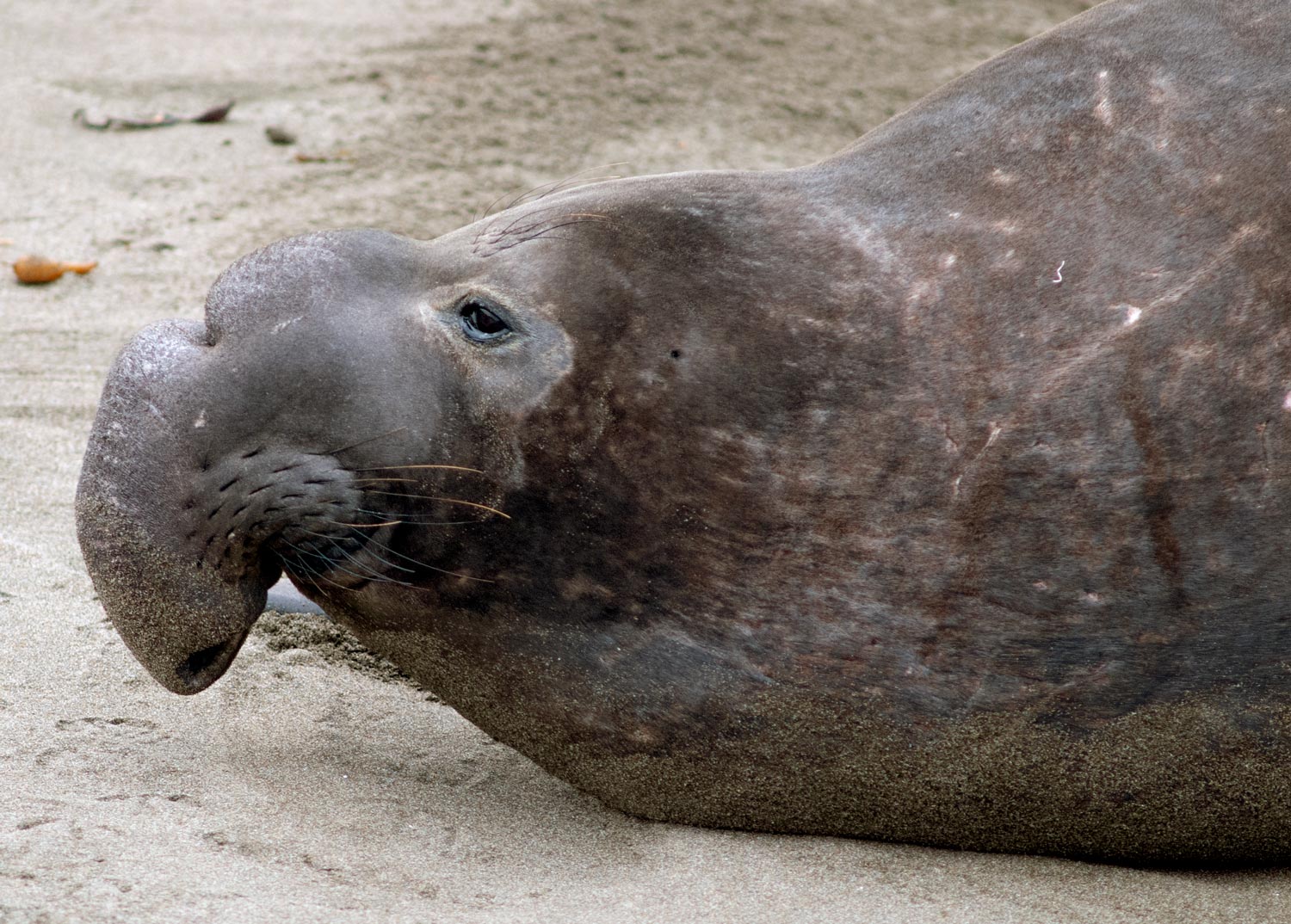California’s Sea Monsters
Photos by Forrest Anderson
Every fall and winter north of San Simeon, California, an extraordinary event unfolds – the annual migration and birth of the largest seals in the northern hemisphere.
They are called elephant seals because the males are 14-16 feet long, weigh 3,000-5,000 pounds and have a long nose and the females are 9-12 feet long and weigh 900-1,800 pounds. They migrate to the shore not just in the fall and winter, but again in the late spring and summer to molt and grow hair.
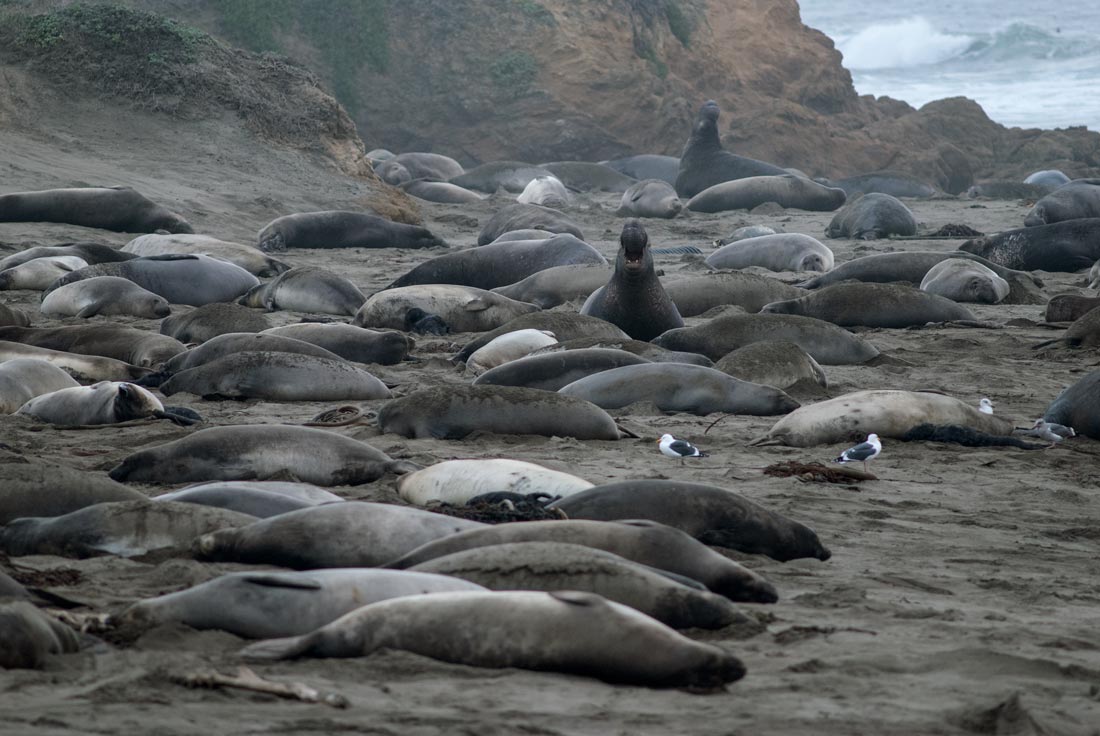
Elephant seals at San Simeon State Park in California.
The seals live in the eastern and central North Pacific Ocean from Baja, California, to the Gulf of Alaska. They birth, breed and molt on islands and the mainland in an area from mid-Baja California to mid-California.
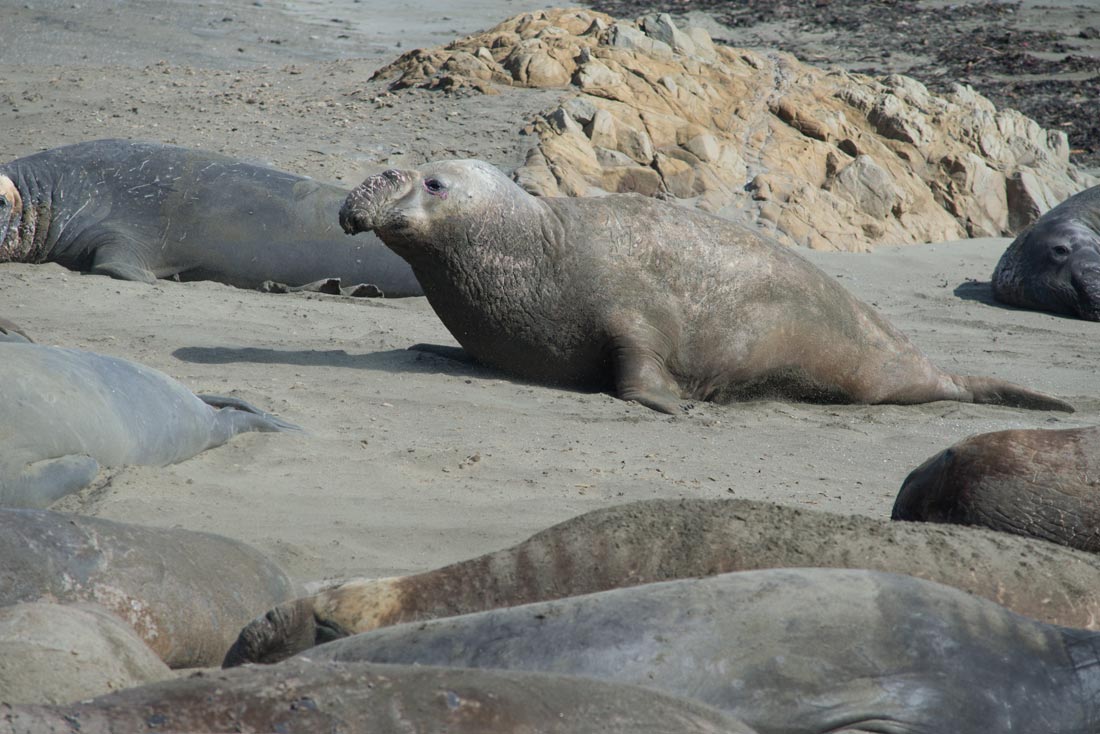
A male elephant seal.
Scientists tracking them with GPS have determined that their range is as far as 3,000 miles from their rookeries. Most swim in the Pacific Ocean between the American coast and Hawaii, with isolated seals having been found as far away as Japan.
Juvenile elephant seals begin arriving at the rookeries on the coast in September. Although they are too young to participate in the birthing and breeding that comes later, they gain experience in the annual migration ritual. Males older than five years start to arrive in late November through December. The larger ones lay claim to sections of the beach. A dominant alpha male and 2-3 sub-dominant beta males typically control a section of the beach. Dramatic battles are sometimes fought between the males to determine these dominant groups. Fights are brutal and often draw blood and cause injuries although the seals settle most confrontations by the dominant male chasing off less dominant ones. Males unable to establish harems wait on the periphery and try to mate with nearby females. The mature males’ floppy hooked nose allows them to make a loud challenge call in the competition for females. Males develop this nose when they reach puberty at about five years old.
This video shows elephant seals on the beach in the winter and a battle between two males just off shore.
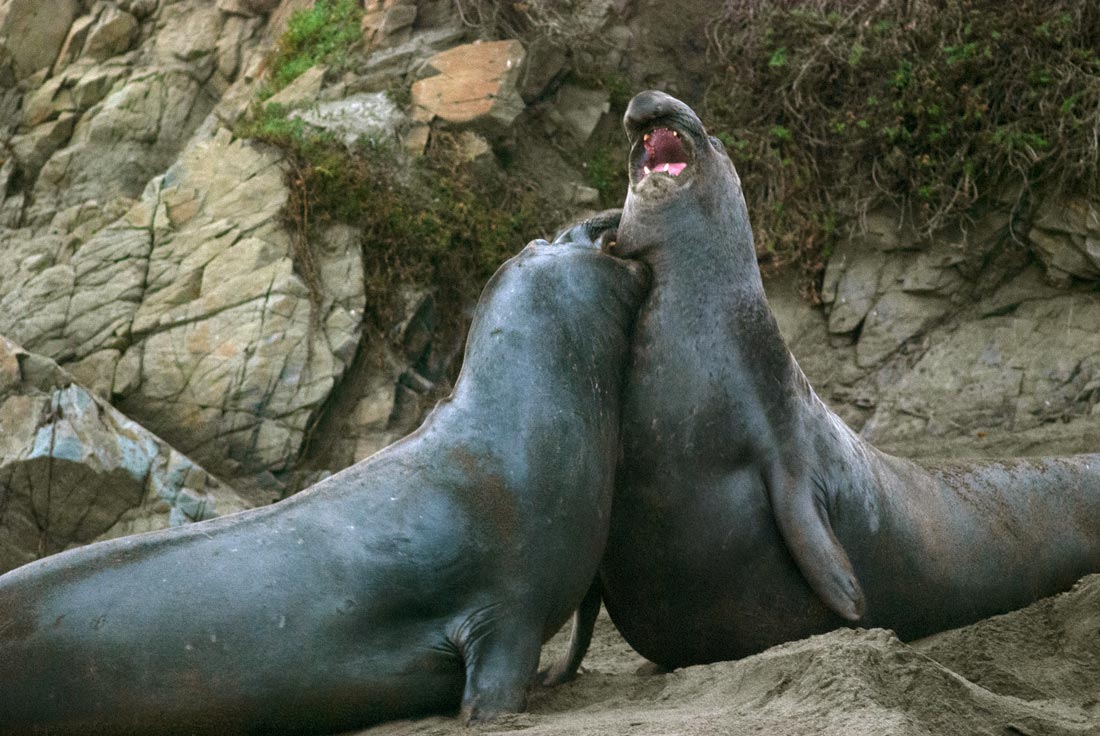
Male elephant seals fight for dominance, above and below.
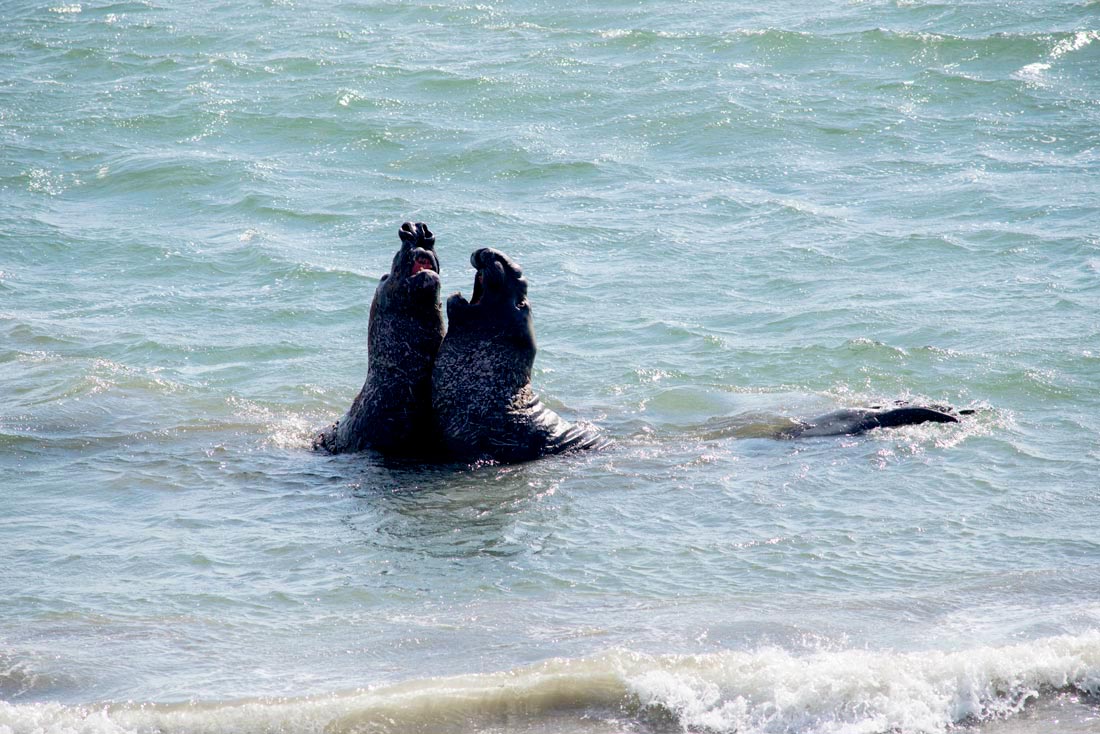
Females who have been pregnant for 11 months start arriving in December, with most coming in January. Their pups are born a few days after they arrive, often at night. The births are single ones. The females nurse their pups for four weeks. During this time, the pups, who are 3-4 feet long at birth and weigh about 70 pounds, quadruple in size to about 300 pounds. The mothers’ milk is about 60 percent fat by the time the pups are weaned. Sometimes, a female can become aggressive after giving birth and will defend her pup from other females. While most females nurse their own pups and reject nursings from alien pups, some will accept alien pups with their own. An orphaned pup may try to find another female to suckle and some are adopted. During her last week of nursing her pup, the mother breeds with a dominant male and then goes out to sea, leaving her pup behind. This is the end of their relationship. The last of the males leave the beach when the females are gone.
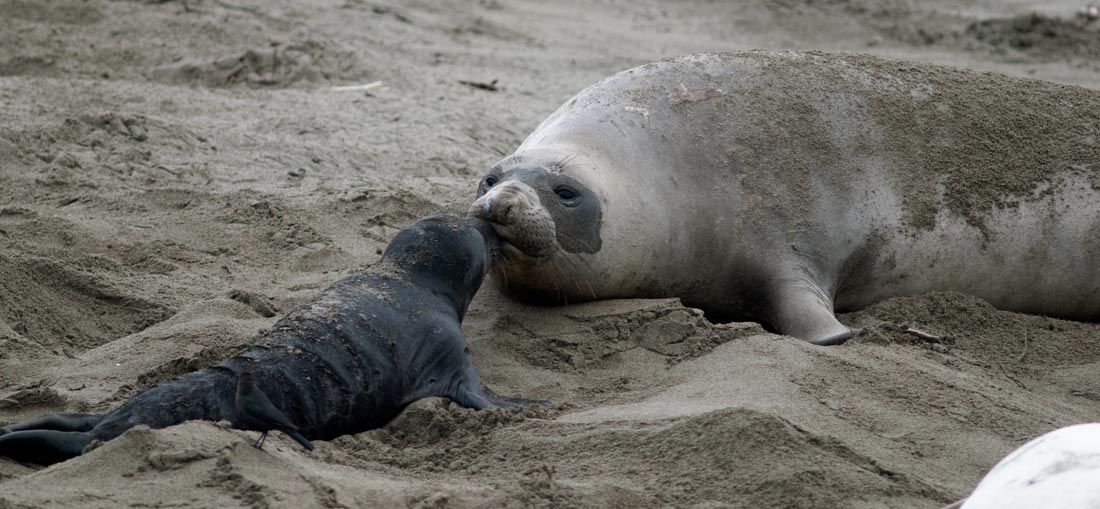
A mother elephant seal and her pup on the beach at San Simeon State Park in California.
The alpha males can impregnate up to 50 females in one season, while sub males may not breed at all. A high-ranking bull can have a harem of 30–100 cows. In a lifetime, a successful male can sire more than 500 pups but most males may never mate because they are chased off.
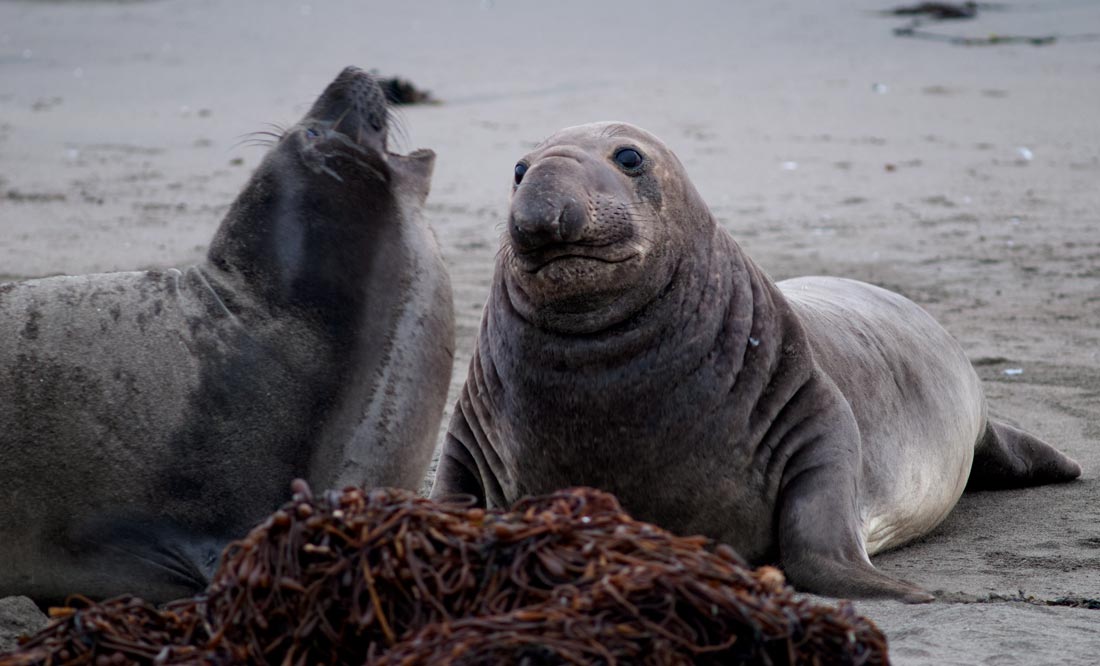
A male and female elephant seal.
Pups nurse for about four weeks and are weaned suddenly a few days before their mother heads out to sea. The weaned pups gather in groups and stay on shore for 12 more weeks. They learn how to swim in the surf and eventually swim farther to forage.
The pups stay in the rookery for another eight to ten weeks, teaching themselves to swim in shallow water off shore. They practice for a while until they can swim well, mostly at night to prepare for dives at sea in the dark. Most of them leave the beach by late March or early April.
This annual months-long ritual is a fast. Except for nursing pups, the seals don’t eat or drink water and don’t breathe when they are resting. The males stay in the rookery for about three months and fast the whole time.
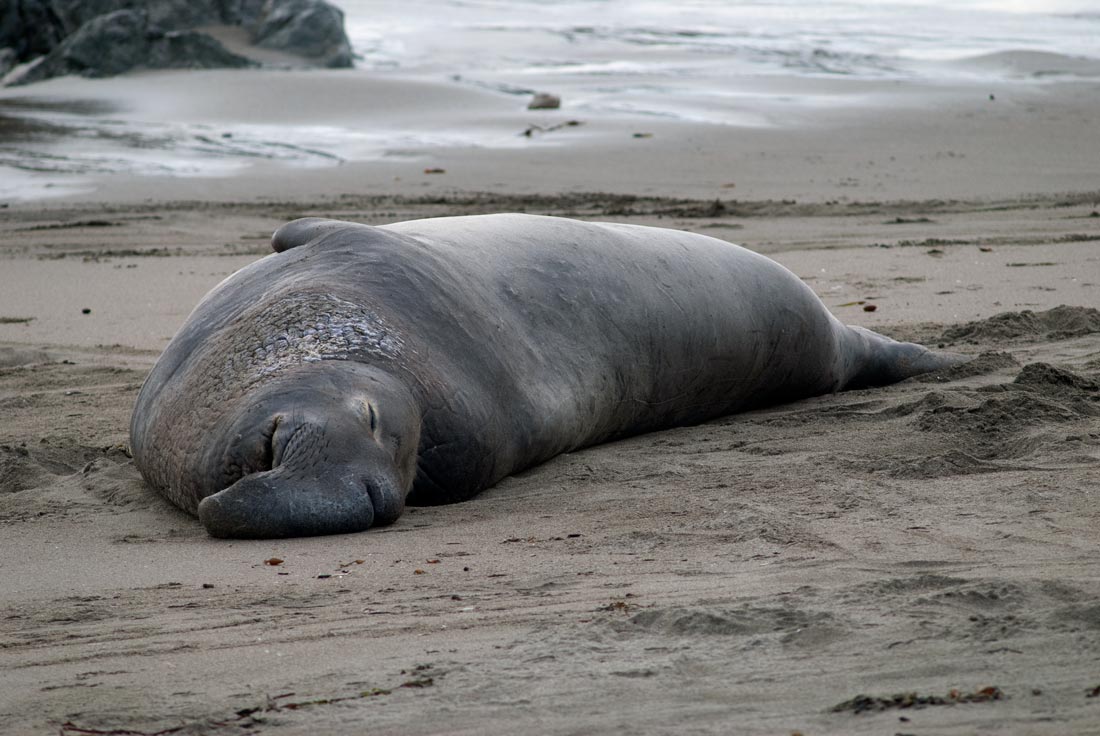
Male elephant seal lying on a beach. The males fast for three months while ashore.
The seals except for the pups return to the rookery for a month sometime in late March-September to grow new skin and hair. They can’t do that in the ocean because they don’t circulate blood next to their skin while swimming around. On land where they are surrounded by air, their blood circulation next to their skin renews and they shed their old skin and hair while growing new. Elephant seals are black before molting. After molting, they have a silver to dark gray coat that fades to brownish-yellow and tan. Pups are mostly black at birth and molt to a silver gray after weaning.
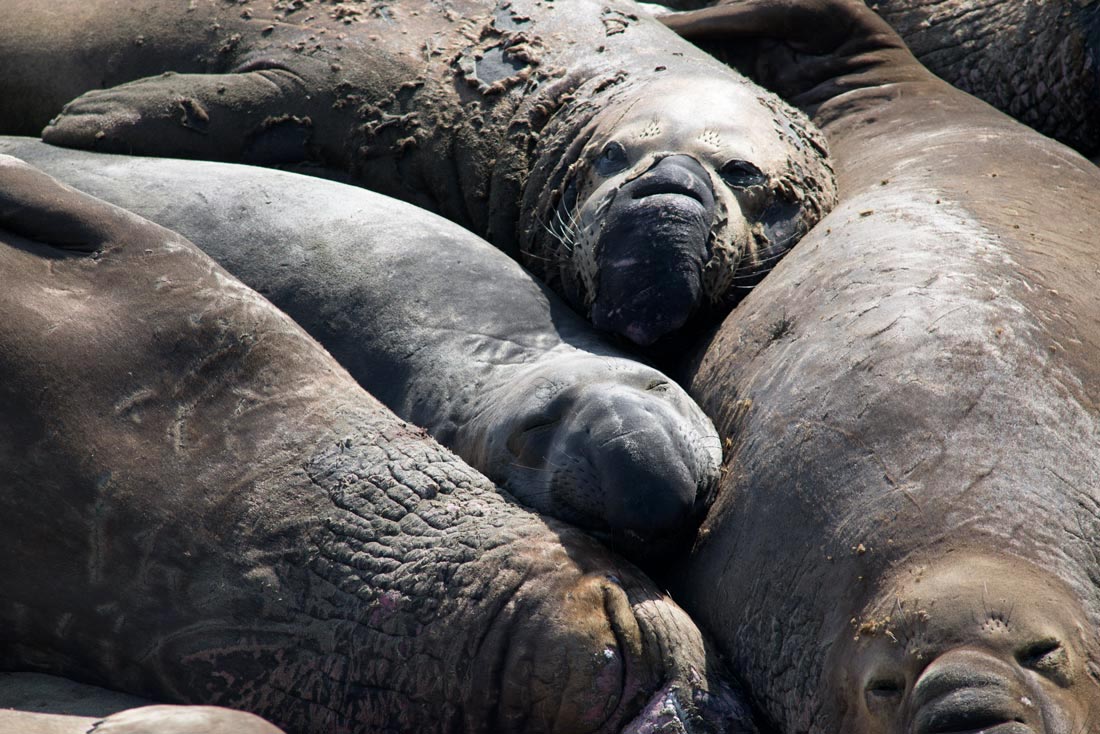
Elephant seals molting in the summer.
The seals spend about ten months of the year at sea, traveling alone and spending 90 percent of the time under water. They dive 1,000-1,300 feet and stay underwater for an average 25 minutes at a time before returning to the surface to breathe for three-five minutes before diving again. The deepest they have been known to dive is 5,800 feet and the longest known time of them staying underwater is two hours. This is their routine 24 hours a day while they are at sea. They don’t stop on land or stay on the water’s surface during this time.
Male elephant seals typically stay along the continental shelf from Oregon to the Aleutian Islands, which are 3,000 miles from California’s Central Coast. They hunt along the continental slope where the shelf drops off, usually along the ocean bottom where they grab and swallow hake, dogfish, rays, octopus and crab. They travel between the rookery and their feeding areas for about five months each year out of the time they are out in the ocean.
The females spend two more months at sea than the males do, and they are primarily out in the deep ocean. They also feed at depths well above the bottom of the ocean. They have eyes that are sensitive to bioluminescent colors of animals at the depth that they feed at and also to predators such as lantern fish and squid. One study indicated that a female elephant seal ingested many small prey. She also did drift diving, when her dives did not go down to foraging depth. Scientists think these dives are for digesting and sleeping. The seal descended like a leaf in drift dives. The female seals travel for two and a half months after weaning their pups and then return to the rookery to molt. Then they travel another seven and a half months before returning for the birthing.
When in a foraging dive, the elephant seals exhale to empty their lungs of almost all air. They thus have less than 40 percent of the oxygen in their lungs that a human diver would, but their blood had almost seven times as much oxygen in it and more than eight times as much in its muscles. This provides the energy the seals need for the rest of their dive. The seal continuously uses its tail fins only at the beginning of the dive, gliding during the rest of the descent and intermittently stroking during the ascent.
The lungs collapse, expelling air to reduce buoyancy and to protect the seals from the bends. The bends are caused when tissue absorbs gases at high pressures while the animal is down deep and that pressure is rapidly decreased as an animal ascends.
To enable them to go for long periods without breathing and recharge rapidly at the surface, seals have different surface and underwater metabolisms. On the surface, the seals take 15-19 breaths per minute and have a heart rate of 80-110 beats per minute. While they are diving, their heart rate drops to a third of the surface rate and sometimes as low as three beats per minute. Their circulation is almost completely to the heart and the brain so that minimal oxygen consumed.
They have a unique ability to store oxygenated red blood cells in their spleens.
Their underdeveloped feet have long webbed fingers used to propel water. These have small veins around their arteries that capture heat.

An elephant seal's webbed fins.
They have black round eyes with a high concentration of low-light pigments.
The seals do v-shaped dives with a vertical speed of 2-5 mph, which is their continuous rate of speed while at sea. They can accelerate up to 10 mph. They swim about 15,000-20,000 miles per year. On land, they are much less dexterous. They use their fins to lumber up the beach. They can move up to about four miles per hour for short distances.
The ocean is dangerous, and many seals don’t survive, although the typical one lives for nine years. Pups can be carried out to the ocean before they can swim well, be unintentionally crushed by a male seal or starve if they become separated from their mother and can’t find a surrogate mother to feed them. In mild weather years, 4-7 percent may not survive, but in a cold year with major storms, 20 percent can die.
Major predators for adult seals are the great white shark and the orca and killer whales. The shark is most likely to ambush a seal with a damaging bite and wait until it is weakened by blood loss to finish the kill.
They also can become caught in fishing nets and drown, starve if they can’t find enough food or contract diseases or parasites. In one study of seals at the Año Nuevo rookery, only about two-thirds of males survived each year and six out of seven females.
Historically, though, the biggest threat to seals has been hunters. In the 18th-20th centuries, they were hunted almost to extinction for their blubber, which was processed into oil for lamps and lubrication. One account said that 210 gallons of oil were taken from one large 18-foot male. The last surviving colony on Guadalupe Island had fewer than 50 seals and it was thought for some time that they would not recover. They were thought to be extinct until 1892 when a Smithsonian expedition found eight of them. The expedition members promptly killed seven of them for their scientific collections. However, the animals survived elsewhere. The development of kerosene as a substitute for lamp oil and Mexico’s passage of laws in 1922 followed by U.S. and California protection laws protecting the seals had allowed their population to increase to 170,000-225,000. They still are considered threatened, but not endangered.
They remain threatened because the surviving group has suffered a loss of genetic diversity, which makes them vulnerable. The population in California is growing at about 6 percent annually and new colonies are being established. Severe weather and El Nino events affect them adversely. For example, El Niño in 1997-98 may have wiped out 80 percent of that year’s pups.
Most of the seals’ rookeries are in California and northern Baja California. There are significant breeding colonies at Channel Islands, Año Nuevo State Park, Piedras Blanca Light, Morro Bay State Park and the Farallon Islands in the United States and at Isla Guadalupe, Isla Benito del Este and Isla Cedros in Mexico. In recent years, the seals have extended their breeding range to Castle Rock in Northern California, Shell Island off Oregon and Race Rocks in British Colombia. The California breeding population is demographically isolated from the Baja California population.
Piedras Blancas in Big Sur is the largest mainland breeding colony, attracting about 20,000 seals.
In Point Reyes, a smaller colony of about 100 seals can be seen from Elephant Seal Overlook near Chimney Rock and above Drakes Bay. Wildlife management employees normally shoo them away by shaking blue tarps to help keep them and humans safe from each other. However, during the latest government shutdown, there weren’t enough workers to do that, and the seals moved in. They broke wooden railings, lumbered into the parking lot and picnic table area and onto the ramp leading to the visitors’ center. Park officials had to temporarily close the beach to protect the seals, especially females who were giving birth there. Point Reyes has about 1,500 elephant seals, which usually stick to the secluded Chimney Beach.
There were no elephant seals near San Simeon before 1990, but the site now has more breeding animals than Año Nuevo State Park. At San Simeon State Beach, about 18,000 elephant seals crowd four miles of beach. Año Nuevo also receives thousands of seals. The main locations to see the seals are at Hearst-San Simeon State Park and the elephant seal vista point about five miles north of Hearst Castle on the central coast and at Año Nuevo State Park along the San Mateo coast south of San Francisco.
At Año Nuevo State Park, no individuals were seen until 1955 and the first pup born there was in the early 1960s, but thousands of pups are born annually there now on the island and mainland. Off Highway 1 near Pescadero, Año Nuevo State Park is the world’s second largest mainland breeding colony of northern elephant seals.
Here’s a schedule of the seal activities you can see in the fall, winter and early spring:
In November, sub adult males first arrive and then mature males at the end of the month.
In December, mature males continue to return, females arrive and the first birth is mid-month.
In January, females continue to arrive and the births peak in the last part of the month.
In February, births continue and the seals mate. Females start to leave.
In March, the last adults leave and weaned pups practice swimming.

A male elephant seal.
Check out these related items
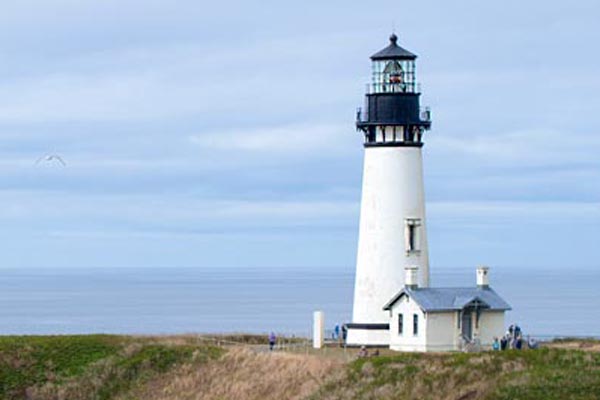
Lighthouse, Tide Pools and Seals
Yaquina Head, Ore., has one of the Pacific Coast’s premier tide pool observation sites, a lighthouse and seal and seabird colonies.

Why Isn’t Every Town Like Carmel?
Carmel, California, demonstrates how design, planning and environmentalism can enhance a small town.
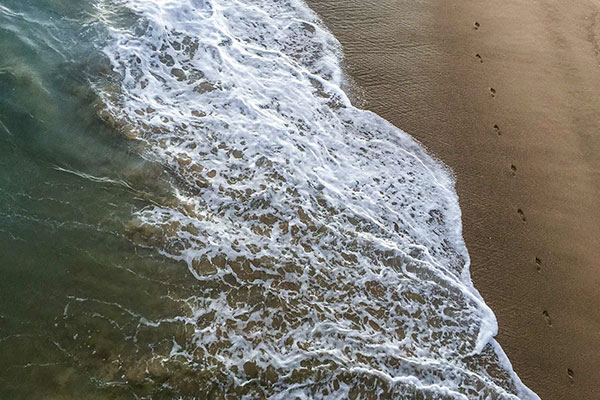
Salt Water Cure, Change of Scene
Changes in the air, the light and the sounds all add up to a new perspective.
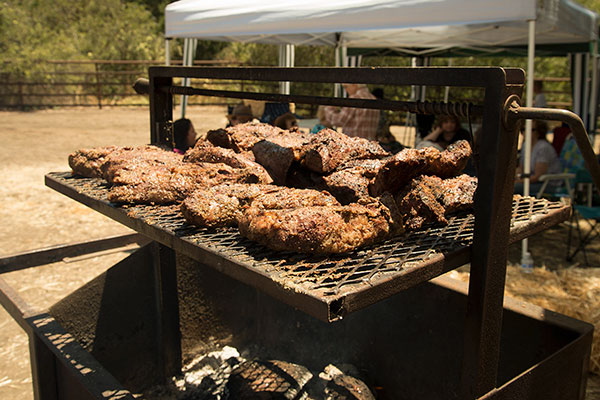
Barbecue Santa Maria Style
Santa Maria's scrumptious grilling is California's premier barbecue style.
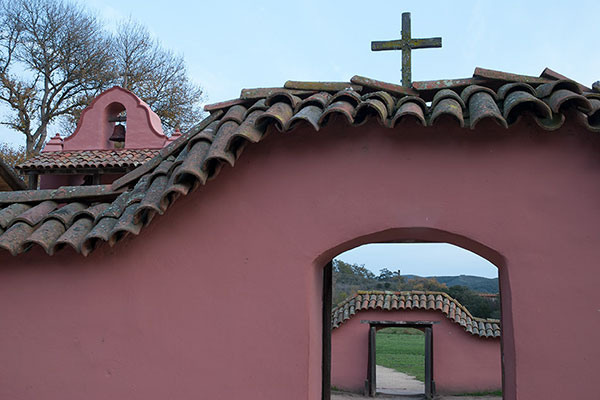
The Land of Junipero Serra
Junipero Serra's "sainthood" is controversial, but the extent of his cultural impact on California is indisputable.

California’s Danish Village
Solvang, California's Danish village, is the perfect place to take an afternoon stroll and enjoy pastries and art galleries.
